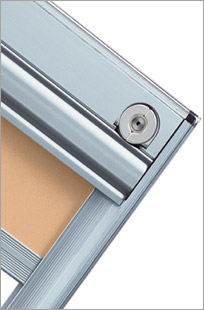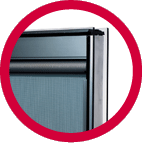
ROLLER BLIND IN DOUBLE-GLAZING UNIT
The ScreenLine® SL27 Roller blind is a totally new magnetic system containing a roller blind integrated within a double-glazing unit with a 27 mm. cavity without compromising the integrity of the unit seal. There are two different models: SL27C Roller with manual cord operation and SL27M Roller with motorised operation through an internal motor.
In the SL27C Roller system, the movement of the blind is controlled by an external rotational magnet, driven by a continuous cord loop, which interfaces with an internal rotational magnetic device contained within the head rail.
Specially designed corner keys, which are inserted in the side guides, incorporate the winding mechanism and the tube on which the fabric is rolled. The SL27M Roller system has an internal motor installed within the head rail that produces the raising / lowering movement of the roller blind.
The magnetic mechanism positioned at the top of the unit is designed to allow the maximum light transfer through the total window area when the blind is raised. By incorporating special guides at the sides and bottom, expressly designed to achieve an easy movement of the bottom rail together with complete fabric enclosure, total black out conditions are obtained.
The use of Verosol fabrics, specially manufactured by the "three chambers method", which have an aluminium coating on the outer surfaced, allows variable light control (transparent, semi-transparent and opaque versions). A reduction of light transmission to 0.3% using the opaque fabric is possible (i.e. black out conditions).
 The SL27M Roller system is therefore ideally suited to installation in environments such as hotel rooms, cinemas, hospitals and laboratories i.e. whenever daylight needs to be periodically reduced or even eliminated together with the requirements for a maintenance free permanently clean encapsulated system.
The SL27M Roller system is therefore ideally suited to installation in environments such as hotel rooms, cinemas, hospitals and laboratories i.e. whenever daylight needs to be periodically reduced or even eliminated together with the requirements for a maintenance free permanently clean encapsulated system.
The improved insulating characteristics of the cavity coupled with the shading characteristics of the roller blind make this system ideal for the replacement of internal or external conventional shading systems together with a reduction in costs for these types of installations.